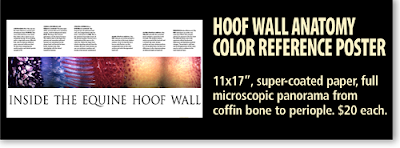Today the Grayson Jockey Club Research Foundation announced its selection for the 2011 round of equine research projects that will be funded.
Laminitis research figured prominently in the mix of subjects to be studied. In particular, two studies will receive support from the Lexington, Kentucky-based charitable organization.
The first covers the dreadful form of laminitis that led to the death of 2006 Kentucky Derby winner Barbaro. This will be a multiple-year study; "first year" refers to the funding applied for 2011. Andrew van Eps received his PhD at the University of Queensland in Australia by studying laminitis; his previous contributions have included the first studies of the use of cryotherapy to prevent laminitis.
Here are the Grayson descriptions of the new studies:
| Laminar Energy Failure in Supporting-Limb Laminitis |
| Dr. Andrew Van Eps, University of Queensland--First Year |
 |
| Andrew Van Eps BVSc, PhD, MACVSc, DACVIM |
A frequent and disheartening result of injury repair is that the leg opposite the one injured develops laminitis. This is known as supporting-limb laminitis and is what eventually caused Barbaro to be euthanized. Although it is a common occurrence, the mechanisms of the malady have not been established.
This project is headed by a young researcher, but the co-investigators are world renowned Drs. Dean Richardson and Chris Pollitt.
 |
| Professor Chris Pollitt BVSc, PhD |
The project involves testing the hypothesis that supporting-limb laminitis is a result of reduced blood supply to the connection between hoof and bone (lamellar tissue). Further, that the blood supply in normal circumstances is encouraged by a regular loading and unloading of the legs and hooves (alternating which one is bearing the most weight). Injury to one leg interrupts that alternating pattern.
The researchers will test the hypothesis with a state of the art, minimally invasive technique known as tissue mycrodialysis in conjunction with three dimensional computed tomography to develop effective methods of preventing or minimizing lamellar tissue energy failure.
Comments in the Research Advisory Committee evaluations included “may well provide immediately applicable strategies to prevent supporting-limb laminitis” and “really nice grant, new idea about a devastating problem.”
Dr. Richardson received second-year funding for his ongoing study of laminitis:
| In Vivo Gene Transfer for the Treatment of Laminitis |
Dr. Dean Richardson, University of Pennsylvania--Second Year
 |
| Dean Richardson DVM, DACVS |
This project seeks to develop a gene therapy approach to prevent laminitis in the contralateral hoof when a horse is being treated for a musculoskeletal injury. This, of course, was what eventually ended the efforts to save Barbaro and is a frequent threat to horses with hoof and leg injuries. The well known research team already has compelling preliminary data which encourages the hypothesis that use of recombinant adeno-associated viruses can be used as vectors to deliver a therapeutic gene (TMP-3) to the lamellar tissues. This is meant to inhibit the damage to the epidermal laminae without disrupting the normal hoof structure. |
Another completely new study will begin at The Ohio State University, where the mechanism of cryotherapy in averting laminitis will be studied and, hopefully, recreated via pharmacology.
| Digital Hypothermia in Laminitis: Timing and Signaling |
| Dr. James Belknap, The Ohio State University--First Year |
The most recent figures from a study involving the USDA and State Veterinary Medical Officers project that at any given time laminitis affects 8 of every 1,000 horses in the United States. Based on the American Horse Council survey that there are 9.5 million horses in the nation, that would indicate 76,000 horses being affected at any given time. Of those affected, the USDA survey found that 4.7% died or were euthanized, or about 3,572 deaths from laminitis annually.
The authors of this project report that “an integrated research effort over the last decade has enhanced the current understanding of the pathophysiology of equine sepsis-related laminitis (one of numerous causes of the disease). This has mirrored progression of sepsis research in human medicine by moving from (an earlier) concept . . .to determining that a marked inflammatory injury takes place and is likely to play a prominent role in tissue injury and subsequent failure.”
However, there have been persistent failure of systemic therapies for organ/laminar injury in both human and equine medicine. One advantage laminitis presents is that it effects the hoof rather than visceral organs, lending itself to artificial cooling more readily. In a present project funded by the Foundation, digital hypothermia (cooling of the hoof) prior to onset of carbohydrate overload-induced equine sepsis resulted in dramatic decrease in laminar inflammatory signaling.
The next goal is to find pharmaceutical therapies which can accomplish the same without the cumbersome aspects of maintaining constant hypothermia to the equine hoof (hooves). |
|

Disclosure of Material Connection: I have not received any direct compensation for writing this post. I have no material connection to the brands, products, or services that I have mentioned, other than Hoofcare Publishing. I am disclosing this in accordance with the Federal Trade Commission’s 16 CFR, Part 255: Guides Concerning the Use of Endorsements and Testimonials in Advertising.



